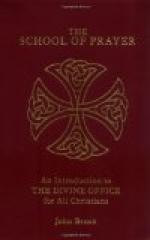“The ‘Benedictus’ or Canticle of Zachary recalls the Precursor’s mission of proclaiming the Messiah and the new alliance. It is altogether appropriate to the Office of daybreak, as ushering in the dawn of a new era. The closing verse speaks of the light which the announcement of the Messiah shed upon the nations ’sitting in darkness and in the shadow of death’” (Dom Cabrol, Introduction to Day Hours of the Church).
“This Canticle of Zachary (St. Luke i. 68-79) naturally falls into two parts. The first (verses 68 to 75, ’Benedictus Dominus ... diebus nostris’) is a song of thanksgiving for the fulfilment of the Messianic hopes of the Jews, to which is given a Christian sentiment. The power, which was of old in the family of David for the defence of the nation, is being restored, and in a higher and more spiritual sense. The Jews mourning under the Roman yoke prayed for deliverance through the house of David. The ‘deliverance,’ a powerful salvation (’cornu salutis nobis’) was at hand so that the Jews were seeing the fulfilment of God’s promise made to Abraham, and this deliverance, this salvation was such that ’we may serve Him without fear in holiness and justice, all our days’ (St. Luke i. 75).
“The second part of the canticle (verses 76-80, ’Et tu puer ... ad dirigendos pedes nostros’) is an address by Zachary to his own son, who was to take an important part in the scheme of the powerful salvation and deliverance by the Messiah. This canticle is known as the canticle of joyous hope, hence its use at funerals at the moment of interment, when words of thanksgiving for the Redemption are specially in place as an expression of Christian hope” (Catholic Encyclopedia, art. “Benedictus").
Oratio (Title XXX.). The word oratio has various meanings. In the liturgy it is translated by the word “collect.” The word “collect” means either that the priest who celebrates Mass collects in a short form the needs, the thanksgivings and the praises of the people, to offer them up to God; or most probably “the original meaning seems to have been this: it was used for the service held at a certain church on the days when there was a station held somewhere else. The people gathered together and became a collection at the first church; after certain prayers had been said they went in procession to the station church. Just before they started, the celebrant said a prayer, the oratio ad collectam (ad collectionem populi), the name would then be the same as oratio super populum, a title that still remains in our Missal, in Lent, for instance, after the Post-Communion. This prayer, the collect, would be repeated at the beginning of Mass at the station itself. Later writers find other meanings for the name. Innocent III. says that in this prayer the priest collects all the prayers of the faithful” (De Sacr. Altar. Mystic. ii., 2). See also Benedict XIV. (De SS. Missae Sacr. ii., 5,—Dr. A. Fortescue, Cath. Encyl., art. “collect").




